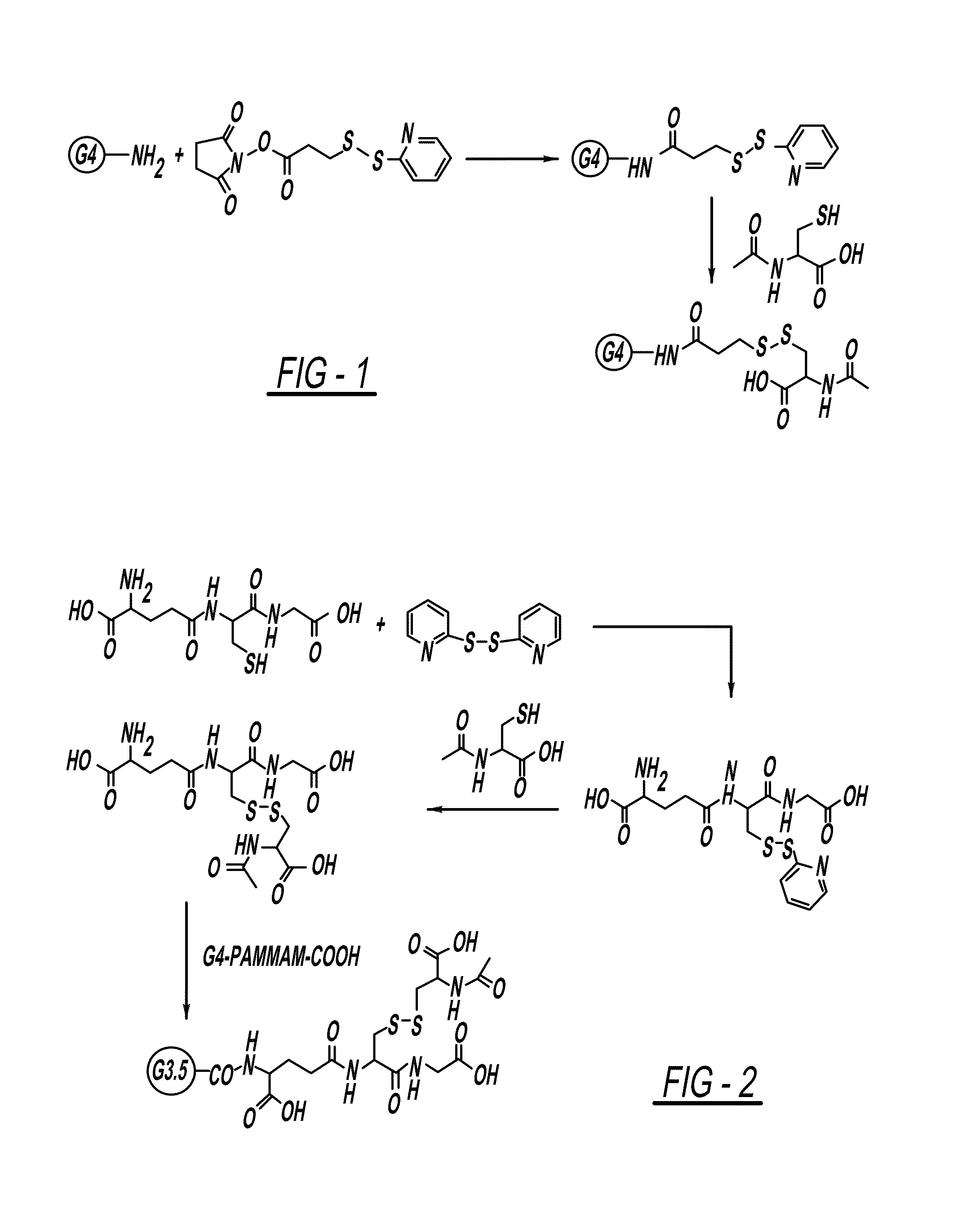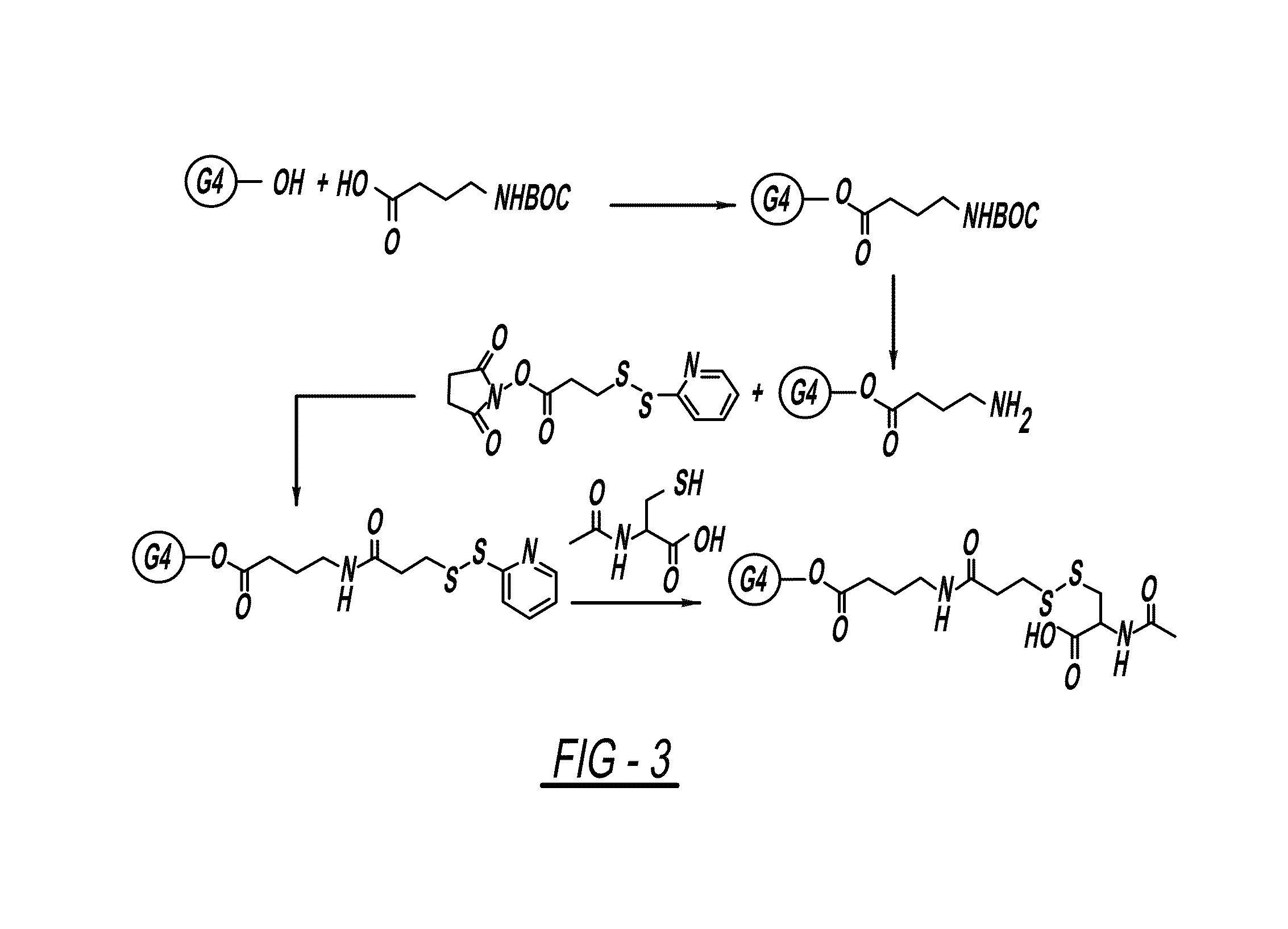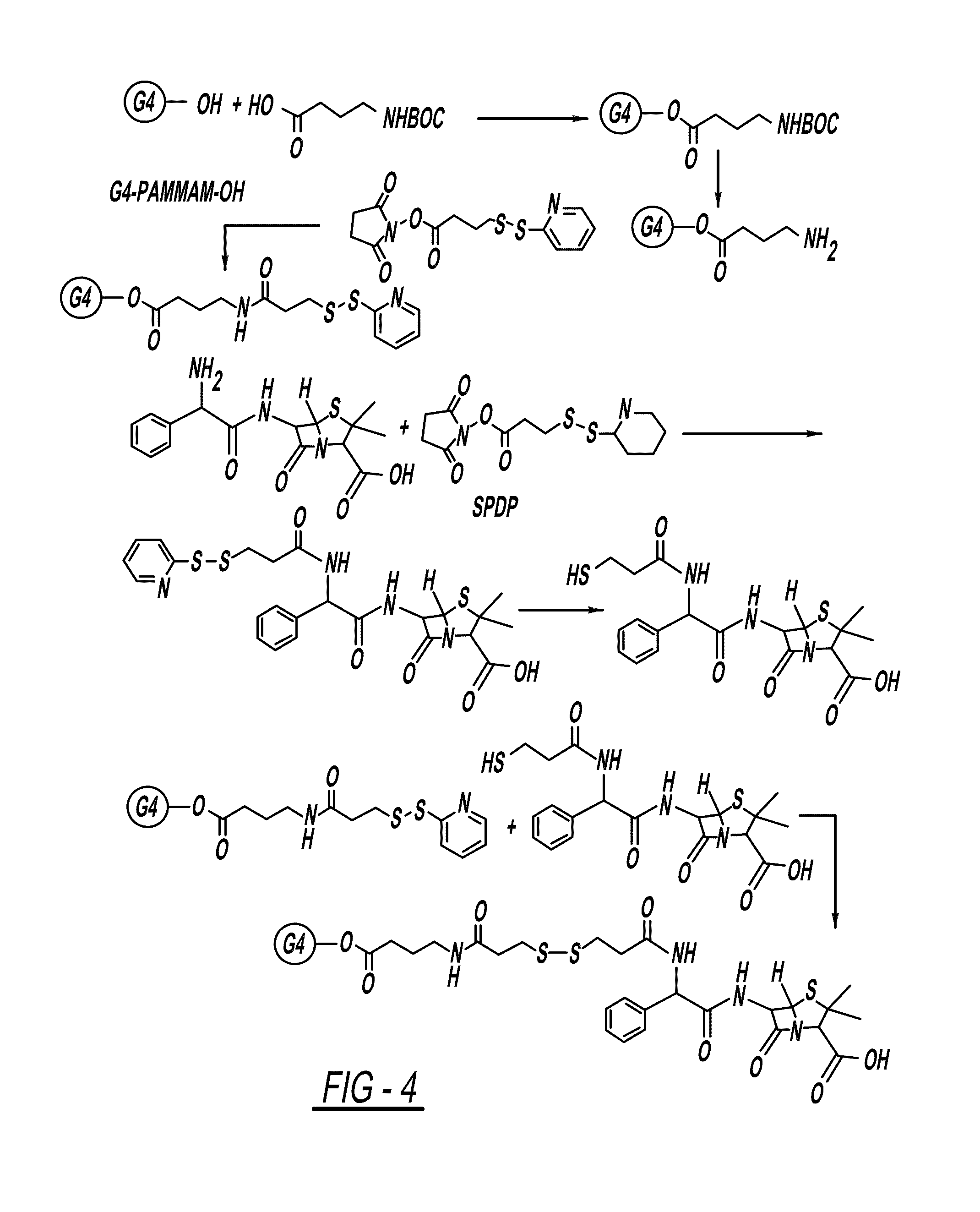Dendrimer based nanodevices for therapeutic and imaging purposes
a nano-device and dendrimer technology, applied in the field of dendrimer-based nano-devices for therapeutic and imaging purposes, nano-devices, etc., can solve the problems of complex and expensive process of viral vector preparation, inability to detect and detect dendritic cells, and inability to detect dendritic cells,
- Summary
- Abstract
- Description
- Claims
- Application Information
AI Technical Summary
Benefits of technology
Problems solved by technology
Method used
Image
Examples
example 1
PAMAM-NH—CO-Ethyl-S—S-NAC Conjugate
[0144]For the preparation of PAMAM-PDP generation 4, SPDP (0.5 equivalent) in ethanol (10 mL) was added to a solution of PBS buffer pH 7.4 (20 mL) and PAMAM-NH2 dendrimer (1 equivalent) to provide sufficient modification whilst preventing loss of product due to the precipitation of highly modified dendrimer. The reaction was stirred at room temperature for 2 hours. To this reaction N-Acetyl cysteine was added (1 equivalent) at once, and the reaction was stirred at room temperature for 4 hours. The reaction was monitored with HPLC. After completion of reaction, the reaction mixture was diluted with water and lyophilized to get crude product. The solid crude product was diluted with water and dialyzed against DMSO followed by PBS (pH=7.4) to remove by-products and the excess of reactants, and then replaced with deionized water (1 in 41 times) for 12 h to remove salts. The water was lyophilized to get pure product in good yield (71%).
example 2
PAMAM-CO-GS-S-NAC Conjugate
Step 1. S-(2-thiopyridyl)glutathione
[0145]S-(2-thiopyridyl)glutathione was prepared from the reaction of 2,21-dithiodipyridine (2 equivalent) and GSH (1 equivalent) in a mixture of methanol and water (1:1) stirred for 15 hours at room temperature. Upon completion of the reaction (monitored by TLC), most of methanol was removed in vacuo and the residue was dissolved in water washed with dichloromethane. The aqueous solution was subjected to reverse phase (RP) HPLC purification, and lyophilization of the eluent gave the pure product as a white solid in 80% yield. Calculated mass: 416. ESI m / z 417 (M+H). 1H-NMR (300 MHz, d6-DMSO) δ / ppm 1.98-2.11 (2H, m), 2.22-3.02 (2H, m), 2.98-3.08 (1H, m), 3.18-3.22 (1H, m), 3.65-3.71 (2H, m), 3.95-402 (1H, m), 4.57-4.62 (1H, m), 7.0-7.07 (1H, m), 7.72-7.87 (2H, m), 8.24 (2H, br.s., NH), 8.42-8.48 (3H, m, NH2, aromatic).
Step 2. N-Acetyl-glutathione
[0146]S-(2-thiopyridyl)glutathione (1 equivalent) was dissolved in PBS buffer...
example 3
PAMAM-O-GABA-NH—CO-Ethyl-S—S-NAC
Step 1. Synthesis of PAMAM-O-GABA-BOC
[0148]A solution of BOC-GABA-OH (1.5 equivalent)) in DMSO / DMF (3:1) was cooled to 0° C. and then treated with a solution of EDC (1.5 equivalent), DMAP (0.01 eq) and G4-OH, PAMAM dendrimer (1 equivalent) in DMSO / DMF (3:1). This was left to stir at room temperature for 24 hours. The reaction mixture was purified on dialysis with DMSO (3 times) to remove by-products and the excess of reactants and after dialysis the solvent was removed under lyophilization to get pure compound.
Step 2. Synthesis of PAMAM-O-GABA-NH2
[0149]To a stirred solution of PAMAM-O-GABA-BOC (1 equivalent) was treated with trifloroacetic acid and dichloromethane (1:1, 10 mL). The reaction was stirred at room temperature for 10 min. After completion of the reaction trifloroacetic acid / dichloromethane was removed under rotavapor. Reaction mixture was neutralized with PBS (pH=7.4) on dialysis with water (3 times) and solvent was removed under lyophili...
PUM
| Property | Measurement | Unit |
|---|---|---|
| concentration | aaaaa | aaaaa |
| concentration | aaaaa | aaaaa |
| concentrations | aaaaa | aaaaa |
Abstract
Description
Claims
Application Information
 Login to View More
Login to View More - R&D
- Intellectual Property
- Life Sciences
- Materials
- Tech Scout
- Unparalleled Data Quality
- Higher Quality Content
- 60% Fewer Hallucinations
Browse by: Latest US Patents, China's latest patents, Technical Efficacy Thesaurus, Application Domain, Technology Topic, Popular Technical Reports.
© 2025 PatSnap. All rights reserved.Legal|Privacy policy|Modern Slavery Act Transparency Statement|Sitemap|About US| Contact US: help@patsnap.com



